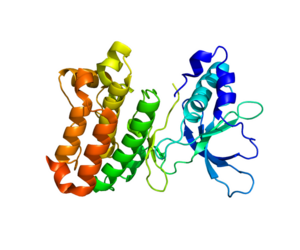EPHA7
من دار الحكمة
اذهب إلى التنقلاذهب الى البحث
EPHA7 (EPH receptor A7) هوَ بروتين يُشَفر بواسطة جين EPHA7 في الإنسان.[1][2] ينتمي هذا الجين إلى الفصيلة الفرعية لمستقبلات الإيفرين من عائلة كيناز البروتين-تيروسين. وقد ثبت أن EPH والمستقبلات المرتبطة به متورطة في التوسط في الأحداث التنموية، وخاصة في الجهاز العصبي. عادةً ما تحتوي المستقبلات في الفصيلة الفرعية EPH على مجال كيناز واحد ومنطقة خارج الخلية تحتوي على مجال غني بالسيستين وتكرارين من النوع الثالث من الفيبرونيكتين. تنقسم مستقبلات الإيفرين إلى مجموعتين بناءً على تشابه تسلسلات المجال خارج الخلية وتقاربها لربط ربيطات الإيفرين-أ والإيفرين-ب.[3]
المراجع
- ↑ Ephnomenclaturecommittee (سبتمبر 1997). "Unified nomenclature for Eph family receptors and their ligands, the ephrins. Eph Nomenclature Committee". Cell. ج. 90 ع. 3: 403–4. DOI:10.1016/S0092-8674(00)80500-0. PMID:9267020.
- ↑ "Entrez Gene: EPHA7 EPH receptor A7". مؤرشف من الأصل في 2010-12-05.
- ↑ "EPHA7 EPH receptor A7 [Homo sapiens (human)] - Gene - NCBI". www.ncbi.nlm.nih.gov. اطلع عليه بتاريخ 2025-01-24.
{{استشهاد ويب}}: تحقق من التاريخ في:|تاريخ-الوصول=(مساعدة)
قراءة متعمقة
- Flanagan JG، Vanderhaeghen P (1998). "The ephrins and Eph receptors in neural development". Annu. Rev. Neurosci. ج. 21: 309–45. DOI:10.1146/annurev.neuro.21.1.309. PMID:9530499.
- Zhou R (1998). "The Eph family receptors and ligands". Pharmacol. Ther. ج. 77 ع. 3: 151–81. DOI:10.1016/S0163-7258(97)00112-5. PMID:9576626.
- Holder N، Klein R (1999). "Eph receptors and ephrins: effectors of morphogenesis". Development. ج. 126 ع. 10: 2033–44. PMID:10207129.
- Wilkinson DG (2000). "Eph receptors and ephrins: regulators of guidance and assembly". Int. Rev. Cytol. International Review of Cytology. ج. 196: 177–244. DOI:10.1016/S0074-7696(00)96005-4. ISBN:978-0-12-364600-2. PMID:10730216.
- Xu Q، Mellitzer G، Wilkinson DG (2001). "Roles of Eph receptors and ephrins in segmental patterning". Philos. Trans. R. Soc. Lond. B Biol. Sci. ج. 355 ع. 1399: 993–1002. DOI:10.1098/rstb.2000.0635. PMC:1692797. PMID:11128993.
- Wilkinson DG (2001). "Multiple roles of EPH receptors and ephrins in neural development". Nat. Rev. Neurosci. ج. 2 ع. 3: 155–64. DOI:10.1038/35058515. PMID:11256076.
- Fox GM، Holst PL، Chute HT، وآخرون (1995). "cDNA cloning and tissue distribution of five human EPH-like receptor protein-tyrosine kinases". Oncogene. ج. 10 ع. 5: 897–905. PMID:7898931.
- Gale NW، Holland SJ، Valenzuela DM، وآخرون (1996). "Eph receptors and ligands comprise two major specificity subclasses and are reciprocally compartmentalized during embryogenesis". Neuron. ج. 17 ع. 1: 9–19. DOI:10.1016/S0896-6273(00)80276-7. PMID:8755474.
- Bonaldo MF، Lennon G، Soares MB (1997). "Normalization and subtraction: two approaches to facilitate gene discovery". Genome Res. ج. 6 ع. 9: 791–806. DOI:10.1101/gr.6.9.791. PMID:8889548.
- Ciossek T، Ullrich A (1997). "Identification of Elf-1 and B61 as high affinity ligands for the receptor tyrosine kinase MDK1". Oncogene. ج. 14 ع. 1: 35–43. DOI:10.1038/sj.onc.1200800. PMID:9010230.
- Hock B، Böhme B، Karn T، وآخرون (1998). "PDZ-domain-mediated interaction of the Eph-related receptor tyrosine kinase EphB3 and the ras-binding protein AF6 depends on the kinase activity of the receptor". Proc. Natl. Acad. Sci. U.S.A. ج. 95 ع. 17: 9779–84. DOI:10.1073/pnas.95.17.9779. PMC:21413. PMID:9707552.
- Bianchi LM، Liu H (1999). "Comparison of ephrin-A ligand and EphA receptor distribution in the developing inner ear". Anat. Rec. ج. 254 ع. 1: 127–34. DOI:10.1002/(SICI)1097-0185(19990101)254:1<127::AID-AR16>3.0.CO;2-Q. PMID:9892426.
- Janis LS، Cassidy RM، Kromer LF (1999). "Ephrin-A binding and EphA receptor expression delineate the matrix compartment of the striatum". J. Neurosci. ج. 19 ع. 12: 4962–71. PMID:10366629.
- Stubbs J، Palmer A، Vidovic M، Marotte LR (2000). "Graded expression of EphA3 in the retina and ephrin-A2 in the superior colliculus during initial development of coarse topography in the wallaby retinocollicular projection". Eur. J. Neurosci. ج. 12 ع. 10: 3626–36. DOI:10.1046/j.1460-9568.2000.00251.x. PMID:11029633.

